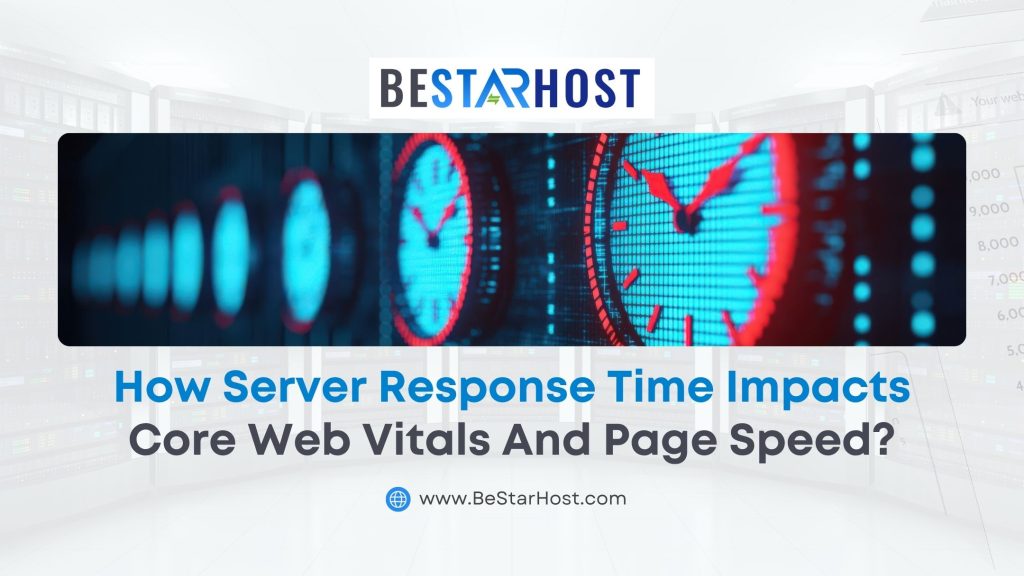
Why Server Speed Matters More Than Ever
Google’s focus on user experience means one thing—speed is now a ranking factor. A slow website not only frustrates users but also lowers your SEO rankings. One of the biggest contributors to page speed is server response time, commonly measured as Time to First Byte (TTFB).
In 2025, businesses aiming for superior core web vitals optimization must prioritize hosting infrastructure that delivers data instantly. This article explains how your hosting setup impacts Core Web Vitals and practical ways to reduce time to first byte.
1. Understanding Server Response Time (TTFB)
Server Response Time is the time it takes for a web server to respond to the browser’s initial request. A slow TTFB means your page starts loading later, delaying every subsequent process—from rendering HTML to loading assets.
Ideal TTFB: <200 milliseconds. Anything beyond 500ms can negatively affect page speed optimization and user satisfaction.
2. How Server Response Time Affects Core Web Vitals
Core Web Vitals—LCP (Largest Contentful Paint), FID (First Input Delay), and CLS (Cumulative Layout Shift)—measure how users perceive your site’s performance.
Here’s how TTFB ties into each metric:
- LCP: A slow response delays the first byte of data, pushing the visible content load further down the timeline.
- FID: Delays in rendering scripts cause slower interactivity.
- CLS: Longer loading times can cause layout shifts as assets load inconsistently.
Thus, faster hosting and efficient backend setups are crucial for comprehensive core web vitals optimization.
3. Common Causes of Slow Server Response Time
- Overloaded or shared hosting servers
- Unoptimized database queries
- Lack of caching (object or page-level)
- Poorly configured PHP workers or NGINX settings
- Absence of CDN (Content Delivery Network)
Choosing high-quality hosting like BeStarHost Web Hosting ensures minimal latency and optimized backend processes, helping you maintain low TTFB consistently.
4. How to Reduce Time to First Byte
Step 1: Choose Fast Servers
Invest in high-speed servers with SSD/NVMe storage. With BeStarHost Dedicated Servers, you get isolated resources—eliminating slowdowns from shared environments.
Step 2: Implement Caching
Use multiple caching layers—browser cache, CDN cache, and server-side object caching (Redis or Memcached). This minimizes round trips and accelerates response times.
Step 3: Optimize Your Database
Regularly clean post revisions, transients, and optimize database tables. Use plugins like WP-Optimize to automate the cleanup process.
Step 4: Use a Global CDN
Integrate Cloudflare or Bunny.net with your hosting to serve content from edge locations closer to users, effectively lowering latency.
Step 5: Upgrade to HTTP/3 and QUIC
Modern protocols reduce handshake times between browsers and servers, improving overall website performance metrics.
5. Measuring Server Performance Effectively
To track and improve page speed optimization, use tools such as:
These tools highlight TTFB, LCP, and other performance bottlenecks. Combine them with BeStarHost performance monitoring for real-time server analytics.
6. The Role of Hosting in Page Speed Optimization
While design and code optimization matter, the biggest performance gains often come from your hosting layer. BeStarHost servers are optimized for:
- Ultra-fast SSD storage
- Built-in caching systems
- Free SSL certificates
- Global CDN integration
- 99.9% uptime SLA
These features combine to deliver exceptional server response time—ideal for developers aiming to meet Google’s Core Web Vitals benchmarks.
7. How Server Response Time Affects SEO and Conversions
Every extra second of delay reduces conversions by 7–10%. Faster response times lead to better user engagement, lower bounce rates, and higher SERP rankings.
By improving your hosting and reducing TTFB, you’re not just boosting technical performance—you’re improving your entire user experience and sales funnel.
Fast Servers, Faster Growth
In 2025, website performance is synonymous with business success. Optimizing server response time directly enhances your core web vitals optimization and page speed optimization metrics.
Upgrade your hosting to BeStarHost.com and experience faster loading, higher rankings, and satisfied visitors—powered by reliable, performance-focused infrastructure.
